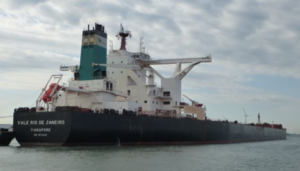What is the Baltic Dry Index?
The Baltic Dry Index can best be described as a weighted average of daily shipping rates for the different classes of dry bulk vessels, namely Capesize, Panamax, Supramax, and Handysize based on a daily survey of agents across the globe. The daily Index is compiled by the Baltic Exchange in London and covers prices for traditional bulk cargoes such as iron ore, coal and grains but also minor bulks such as fertilizers and high value minerals.

Vale Rio De Janeiro, length overall 362m, 402,303 tonnes deadweight
The weighting of each rate is based on the percentage of dry bulk traffic transported by each class of vessel. Capesizes are in the range of 180-200,000 tonnes deadweight (carrying capacity) and by virtue of their intake, make up a little over 60% of dry bulk traffic, thereby having a greater influence on the fluctuations of the index than smaller vessels. However, Capesizes are by no means the largest bulk carriers in service. This title belongs to Very Large Ore Carriers (VLOC) in the range of 3-400,000 tonnes deadweight. See Vale Rio De Janeiro above as an example.
The Index hit a peak on May 20, 2008, when it hit 11,793, a level which few observers ever expect to see again. The lowest level ever reached was on the February 10, 2016, when the index dropped to 290 points. Shipping has never been for the faint of heart!
The Index has seen a steady recovery in 2017, reflecting a slow but steady move towards achieving balance between vessel supply and demand. This is a combination of much reduced orders for new vessels and the steady scrapping of older, less efficient and environmentally non-compliant vessels as new rules related to fuel standards and the mandatory treatment of ballast water begin to take effect.
The lack of orders for new vessels is directly proportional to market prices for new builds as the world’s lading shipyards in China, South Korea and Japan drop prices to attract orders for vessels which in many cases are not required to service market demand.
Growth of the bulk fleet is expected to decline from +3.2% this year to +1.2% in 2018 and for 2019 at a preliminary estimate of +1.8% after accounting for additional deliveries not reflected by the current orderbook.
Sustained Chinese demand for coal and iron ore accounts for most of the recent strength of the BDI according to a recent report by the Baltic and International Maritime Council (BIMCO). The downside to increased market strength is that owners will be tempted to delay the scrapping of older vessels, thereby perpetuating over-supply.

